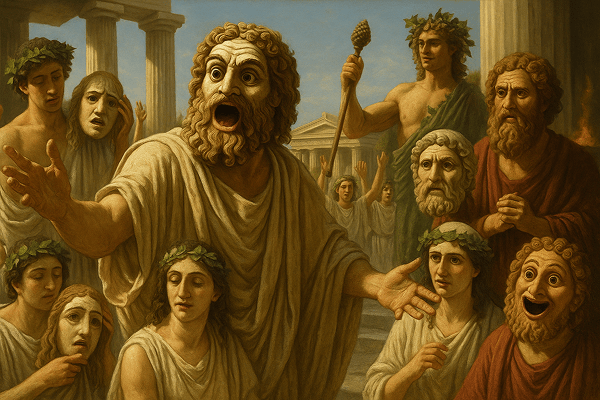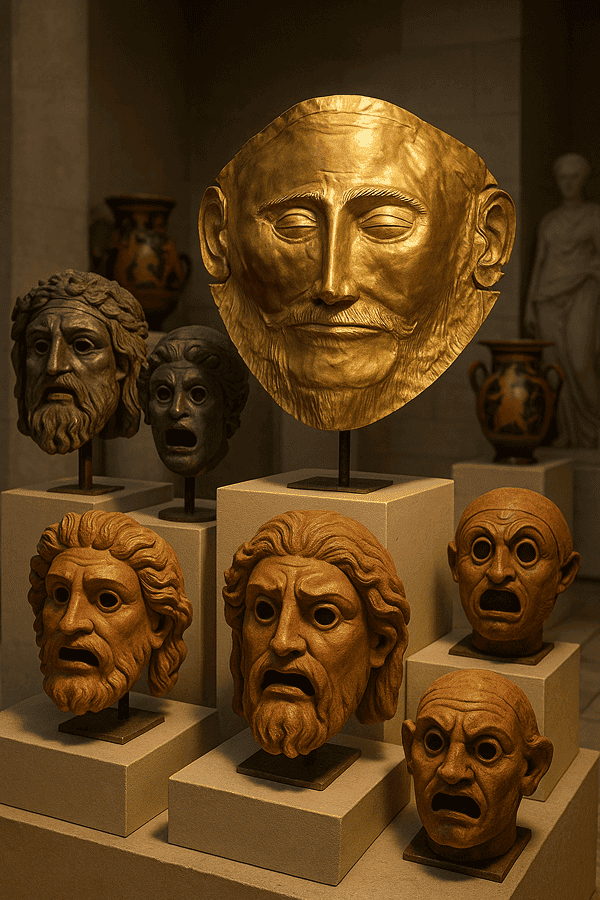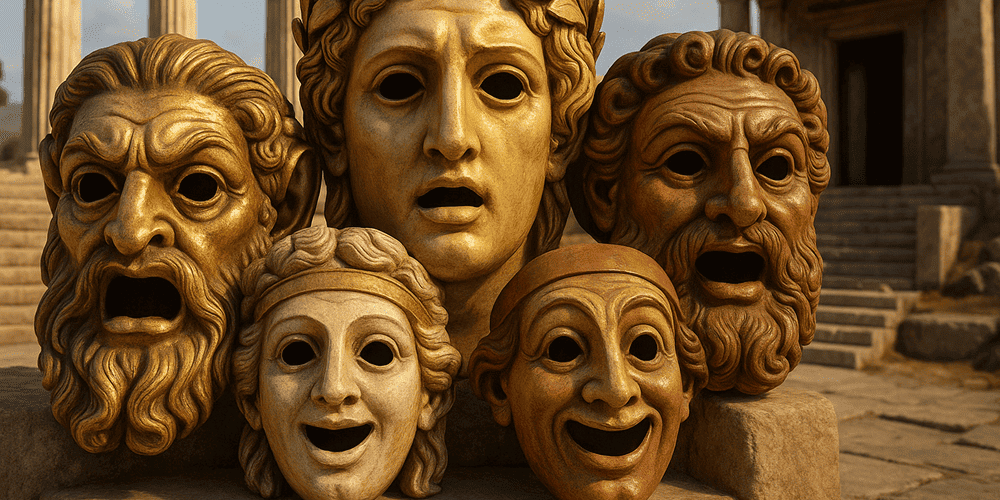Greek Ritual Masks are among the most iconic and enduring symbols of ancient Greek culture, instantly recognizable for their stylized features and deep connection to religion, theater, and communal life. Typically crafted from lightweight materials and painted in natural or vivid hues, these masks display exaggerated facial expressions — wide eyes, arched brows, open mouths — designed to be seen from a distance in large amphitheaters or during public processions. Many feature beards, detailed hair, or ornate headdresses, and some are adorned with animal motifs or gilded accents. Greek ritual masks are primarily associated with the cultural landscape of ancient Greece, especially during the classical period (5th–4th centuries BCE), but their origins stretch back to earlier Mycenaean and archaic traditions. They played a vital role in religious festivals, dramatic performances, and rites dedicated to gods such as Dionysus, the divine patron of theater and transformation.
Historical Origins of Greek Ritual Masks
The origins of Greek ritual masks can be traced to the earliest religious and communal practices of the Aegean world. The Greek word “prosopon” (πρόσωπον) means both “face” and “mask,” reflecting the concept of adopting another identity. Archaeological evidence from Mycenaean tombs and Minoan Crete suggests that masks were used in funerary and initiation contexts as early as the 2nd millennium BCE. With the rise of city-states and the formalization of religious festivals, mask-making evolved into a sophisticated art. During the 6th and 5th centuries BCE, the cult of Dionysus — god of wine, ecstasy, and theater — brought about new traditions of masked performance, culminating in the invention of Greek tragedy and comedy. Ancient authors such as Aristotle, Sophocles, and Aristophanes mention the use of masks in dramatic contests and religious ceremonies. Over time, the design and function of masks adapted to changing tastes, from the naturalistic styles of early drama to the more exaggerated, symbolic forms of later periods. Notable artifacts include terracotta masks from Athens and gold funerary masks from Mycenae, such as the so-called “Mask of Agamemnon.” The tradition of Dionysus Masks, in particular, highlights the close link between ritual, theater, and divine transformation.
Cultural Significance and Symbolism of Greek Ritual Masks
In ancient Greek culture, ritual masks held profound symbolic and spiritual meaning. They allowed participants to transcend ordinary identity and embody gods, heroes, spirits, or mythological beings. In the context of religious festivals — especially the Dionysia — masks were thought to invite divine presence, protect against evil, and foster a sense of communal catharsis. The mask’s exaggerated features amplified emotion, enabling actors and worshippers to channel fear, joy, sorrow, or ecstasy. Myths and legends, such as the tales of Dionysus and his followers, describe how masks could induce trance, inspire prophecy, or heal psychological wounds. Socially, masks broke down barriers between classes and genders, allowing all citizens to partake in the sacred drama. They also served as powerful teaching tools, transmitting moral lessons and cultural values through performance and ritual.

Materials and Craft Techniques of Greek Ritual Masks
Greek ritual masks were traditionally made from lightweight, perishable materials such as linen, wood, cork, leather, or plaster. For theatrical use, artisans would mold the base material over a wooden core, then paint the surface with natural pigments and attach hair, beards, or headdresses. Tools included carving knives, chisels, paintbrushes, and sometimes gold leaf for ceremonial masks. Regional differences emerged: Athenian masks for tragedy were often more restrained and naturalistic, while those for comedy and satyr plays were highly exaggerated and colorful. Color symbolism was important — white for female characters, brown or red for males, gold or black for gods and spirits. Decorative motifs, such as laurel wreaths, animal horns, or geometric patterns, enhanced the mask’s significance and visual impact. Although few original masks survive due to the fragility of the materials, ancient vase paintings, sculptures, and terracotta miniatures provide valuable insight into their appearance and construction.
Functions and Uses of Greek Ritual Masks
The primary function of Greek ritual masks was religious and theatrical. In ceremonies honoring Dionysus, worshippers donned masks and costumes to participate in ecstatic dances, processions, and sacrifices. Theatrical masks became essential to the development of Greek drama, allowing actors to play multiple roles, project their voices, and convey emotion to large audiences. Masks were also used in mystery cults, funerary rites, and seasonal festivals such as the Anthesteria and Thesmophoria. Over centuries, the use of ritual masks expanded and adapted: while their role in mainstream religious life declined with the rise of Christianity, they persisted in folk traditions, carnival celebrations, and modern revivals. Today, Greek ritual masks are featured in educational programs, museum exhibitions, and performances that seek to keep the ancient spirit alive.
Regional Variations in Greek Ritual Mask Traditions
While Athens is the best-known center of Greek ritual mask culture, regional variations flourished across the Hellenic world. In southern Italy and Sicily, Greek colonies developed their own mask styles for local theater and religious rites, sometimes incorporating indigenous influences. The island of Crete preserved Minoan and Mycenaean mask motifs, particularly in funerary and initiation contexts. In the rural north, masks used in agricultural festivals often depicted animals or spirits linked to fertility and the changing seasons. Compared to similar traditions in Etruria, Egypt, or Rome, Greek ritual masks are distinctive for their blend of naturalism, symbolism, and communal function. Each region’s masks reflect local myths, dialects, and artistic preferences, while sharing the unifying themes of transformation and celebration.
Famous Examples and Collections of Greek Ritual Masks
Some of the most renowned Greek ritual masks are preserved in museums and archaeological collections worldwide. The “Mask of Agamemnon,” a gold funerary mask discovered at Mycenae, is one of the most famous artifacts of the ancient world. Terracotta and bronze masks from Athens, Corinth, and southern Italy are displayed in the National Archaeological Museum (Athens), the British Museum, and the Louvre. Numerous vase paintings and sculptures also depict masked performers in dramatic and ritual scenes. Private collections and academic institutions, as well as digital galleries like toddmasks.com, offer further opportunities to study and appreciate these masterpieces. Historical finds, such as theater masks unearthed in Dion and Epidaurus, provide insight into performance practices and mask design.

Influence of Greek Ritual Masks on Art and Culture
The legacy of Greek ritual masks has shaped Western art, literature, and theater for more than two millennia. Their forms inspired Roman and later European mask traditions, including the commedia dell’arte of Italy and the masked balls of the Renaissance. In literature, the mask became a metaphor for transformation, hidden identity, and the tension between appearance and reality. Greek masks have appeared in countless works of art, from ancient mosaics to modern paintings and sculpture. In cinema, theater, and contemporary performance, the imagery of Greek masks continues to evoke the drama, mystery, and psychological depth of the ancient stage. Designers and fashion houses sometimes incorporate mask motifs into their creations, blending classical tradition with modern innovation. The ongoing study and preservation of Greek ritual masks play a crucial role in sustaining cultural heritage and inspiring new generations of artists and scholars.
Contemporary Status and Preservation of Greek Ritual Mask Traditions
Today, the tradition of Greek ritual masks is maintained and revitalized through academic research, museum curation, and artistic re-imagining. Modern artisans and theater groups in Greece produce replica masks for educational, ceremonial, and performance use, drawing on historical techniques while experimenting with new materials and styles. University programs, workshops, and public festivals — often highlighted on toddmasks.com — help transmit the art and meaning of masks to new audiences. Digital technology allows for the reconstruction and virtual display of ancient masks, while international collaborations keep the tradition dynamic and globally relevant. Innovations in performance and design ensure that Greek ritual masks remain a living part of both local and world culture.
Collecting and Acquiring Greek Ritual Masks
The market for Greek ritual masks includes high-quality replicas, contemporary interpretations, and, rarely, ancient artifacts. Authentic ancient masks are extremely rare and are most often found in museums or protected collections due to their archaeological importance. Collectors and enthusiasts can acquire replicas from artisan workshops, galleries, and specialized online resources, with prices varying according to craftsmanship, materials, and provenance. When collecting, it is crucial to ensure authenticity, respect legal and ethical standards, and support artisans and educational initiatives. Toddmasks.com provides guidance on identifying genuine works, understanding the cultural context, and engaging in responsible collecting. Ethical considerations include respecting the sacred and historical significance of masks and ensuring that their acquisition supports cultural preservation rather than exploitation.
